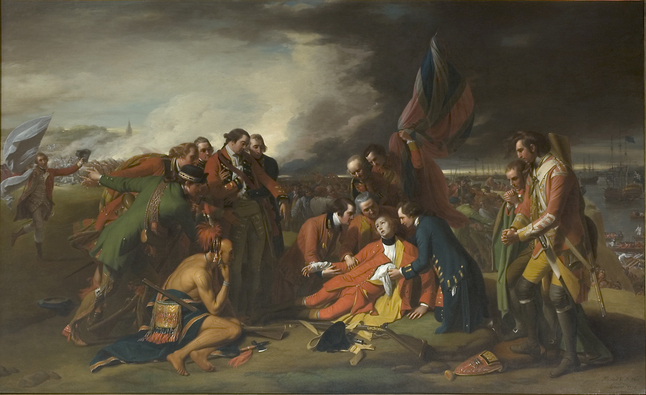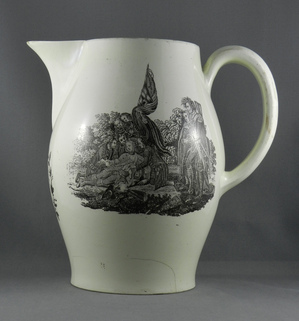UMMA's spectacular 'General Wolfe' exhibit the don't-miss art event this year

"The Death of General Wolfe" by Benjamin West
courtesy of the University of Michigan's William L. Clements Library
Let’s put one undeniable fact on the table: This Benjamin West 1776 oil on canvas painting owned by the U-M’s William L. Clements Library (where it typically holds pride of place) is the single most significant public artwork in Washtenaw County, and among the most significant artworks in our state.
Granted, there are a few other works of art out there that could be said to be relatively important (for example, the UMMA’s 1946 Max Beckmann “Begin the Beguine” would likely get a few votes; and the Detroit Institute of Art obviously has its own trove of masterworks). But “The Death of General Wolfe” is such a complete masterpiece executed on such a masterly oversized scale; it’s incontestably worthy of this accolade.
It’s therefore all the more telling that it’s taken two of the U-M’s richest resources to mount and supplement this monumental artwork in the UMMA’s handsome second-story A. Alfred Taubman Gallery. Because this single gallery, too, is about as good as it gets around these parts.
With additional contributions from the John Clarence Webster Canadiana Collection of the New Brunswick Museum in St. John, New Brunswick; The National Gallery of Canada, Ottawa; The Ashmolean Museum of the University of Oxford; and Quebec House, Westerham, Kent (The National Trust, United Kingdom), it’s safe to say this exhibit is the Ann Arbor fine arts event of 2012.
For “The Death of General Wolfe” is West’s definitive (if not also historically fanciful; but more about that later) interpretation of the death of this famed British general during the Sept. 13, 1759 Battle of the Plains of Abraham—otherwise known as the Battle of Quebec—which was the decisive quarter-hour securing Great Britain’s permanent New World ascendency during the mid-18th Century French and Indian War.
Yet even this historic back story is merely a part of what’s on display in “Benjamin West: General Wolfe and the Art of Empire,” because the larger part of the exhibit revolves around the hero worship that emerged following Wolfe’s death.
As Carole McNamara, UMMA senior curator of Western art (and curator of the exhibit), tells us in her introduction, it is “organized around a remarkable version of a painting that was a phenomenon in its time, indeed perhaps the most famous in late eighteenth-century Britain: ‘The Death of General Wolfe’ by Benjamin West (1738-1820).
“West’s painting was created in 1771 at the height of the mania for all things Major-General James Wolfe (1727-1759) following his stunning triumph over the French at the Battle of Quebec in 1759. This pivotal victory in the French and Indian War (1754-1763) signaled Britain’s ascendency in North America and Wolfe, who died on the battlefield, immediately became a national hero.
“The fervent excitement surrounding his death coincided with the rise of newspapers and the broad availability of affordable consumer goods; these were complemented by an official interest in publicly exhibiting British art and a burgeoning market in prints after well-known paintings.
“Depictions of Wolfe’s tragic death; particularly Benjamin West’s, thus became widely dispersed in many media and helped to shape a nationalism that celebrated Great Britain’s transition into a cultural, economic, and military power.
“‘Benjamin West: General Wolfe and the Art of Empire examines images and objects that created a sense of British imperial identity, from representations of General Wolfe in paintings, prints, and decorative objects marketed to and consumed by an eager public, to the documentation of Britain’s new territories in maps visualizing its vast colonial realm.”
The entire hullabaloo is certainly on display.
As the exhibit’s gallery statement states, “Collected here for the first time are forty-one objects from institutions in the United States, Canada, and the United Kingdom, the majority from two rich collections that stand as American and Canadian counterparts: the William L. Clements Library at the University of Michigan and the Webster Canadiana Collection at the New Brunswick Museum.”
As McNamara tells us, there are a remarkable array of “Wolfe” likenesses and “deaths” on hand in an equally exceptional array of artistic mediums.

"Jug with 'The Death of General Wolfe'" by Josiah Wedgwood
That’s a remarkable array of marketable objects on hand for a single historic event halfway around the world at a time when communication was still at a virtual snail’s crawl. Indeed, in 21st century marketing terms, it might be said that Wolfe’s death was a canny, if albeit unintended, career move. At the very least, his death certainly helped define British Empire heroic sacrifice for a long afterward.
And as the display illustrates, European and American artists were also busily working away on Wolfe commemorative items. Among these works—each a Wolfe portrait or Wolfe death-likeness— are Englishmen Edward Penny’s 1763 oil on canvas “The Death of General Wolfe”; George Romney’s 1763 oil on canvas “Study of General Wolfe, for ‘The Death of Wolfe’,” and Edward Penny’s 1763 oil on canvas “The Death of General Wolfe.”
Germany’s contribution is Carl Guttenberg’s 1789 steel engraving “Der General Wolf (after Benjamin West).” Italian Luigi Schiavonetti’s 1790-1800 sipple engraving is entitled “The Death of General Wolfe (after Nathaniel Marchant).” And Jacques Barbie’s 1770-79 engraving and mezzotint “General James Wolfe (1727-1759)” as well as compatriot Robert De Launay’s hand-colored 1776-1800 “La Mort du General Wolfe a Quebec” engraving ironically illustrate France’s commemoration of the British victory.
Add a 1760-1800 a Catnach Press engraved poem, “Bold General Wolfe”; a 1790 “On the Death of General Wolfe, as Sung at the Anacreontic Society by Mr. Sedgwick” published by Jonathan Fentum circa 1790; and a new world 1775 engraved piece of music published by Robert Aitken entitled “General Wolfe: A New Song Engraved for the Pennsylvania Magazine”—and Wolfe was sung about and versified as much as he was visually idolized.
Yet as much as these supplementary works of art add support to the exhibit’s theme, there’s no question but that Benjamin West’s bravura 1776 oil on canvas “The Death of General Wolfe” rightly dominates the proceedings. West, an American ex-patriot living in London “seized,” as the UMMA’s gallery statement says, “the moment of frenzied admiration of General Wolfe to gain fame, fortune, and immortality by paying homage to the new national hero in paint.”
And as the UMMA explains in an expansive on-site gallery sheet, West pulled out all the classic art stops in his imagining of Wolfe’s demise. Thus the exhausted young general is depicted in the heart of the composition through a triangular tableau reminiscent of proto-Renaissance Italian art through a pose equally reminiscent of Christ’s lamentation.
West also uses imaginary iconography through a foreground, contemplative Native American seated at Wolfe’s feet. While the uniform of an elite Louisbourg Grenadier (formed earlier by Wolfe and named after a captured Nova Scotia fortress) and a background runner carrying a Fleur-de-lis, symbolizing the French army’s defeat, are accurate historic representations.
West’s audience at the time could hardly miss the painting’s symbolism; just as its uncompromising fatalistic heroism did nothing to diminish its grandeur. As such, there can be no denying of the famed painting’s place in the history of art. Nor can the work’s fiery theatrics be understated; for it’s this passionate dramatic impulse that’s made it world famous.
Spectacular is a word that should only be used sparingly, but it’s certainly appropriate in this instance. For “The Death of General Wolfe” grandly holds court over everything else in its immediate UMMA vicinity. Just know that’s the way it ought to be—because that’s the way West meant it.
“Benjamin West: General Wolfe and the Art of Empire” will continue through Jan. 13 at the University of Michigan Museum of Art, 525 S. State St. Museum hours are 11 a.m.-5 p.m. Tuesday-Saturday, and noon-5 p.m. Sunday. For information, call 734-763-UMMA.


Comments
Nancy Goldstein
Thu, Oct 4, 2012 : 12:05 p.m.
I am a docent at UMMA. Others and myself are enjoying this wonderful exhibit that encompasses art, history, politics, and popular culture. We welcome the public to join in the lively discussion on UMMA's docent-led guided tours of Benjamin West: The Death of General Wolfe. Tours are the following Sundays at 2 p.m.: Oct. 14 and 28; Nov. 11 and 25; Dec. 16. We give special group tours upon request.
New Brunswick Museum
Tue, Oct 2, 2012 : 5 p.m.
We are so pleased to be part of this exhibition! Many congratulations to UMMA.
Lovaduck
Mon, Oct 1, 2012 : 10:45 p.m.
There is even a Canadian folk song, "Brave Wolfe" which Ian and Sylvia recorded about 30-40 years ago!
Billy Bob Schwartz
Mon, Oct 1, 2012 : 2:46 p.m.
Sounds great. Love that Clements Library, too! Great painting.